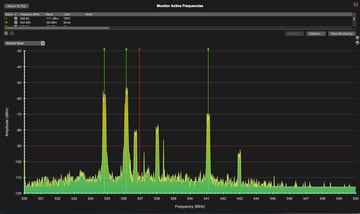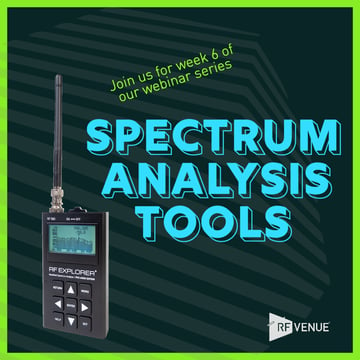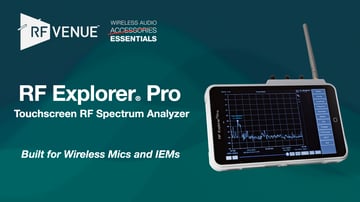- Products
- All Products
- RF PA Extension Kit
- Wireless Microphone Upgrade Packs
- In-Ear Monitor Upgrade Packs
- Wireless Microphone Antennas
- Wireless In-Ear Monitor Antennas
- Antenna Distribution for Microphones
- Antenna Combiners for In-Ear Monitors
- Multi-Zone Antenna Combiners
- Spectrum Tools
- Accessories, Cables and Parts
- Solutions by Venue
- Resources & Training
- Performance Tools
- About Us
Introduction
Every week I receive a number of calls from customers with wireless issues that look a lot like “it was working fine for a year, and now we're having problems”. After asking a few questions I always ask if they can send me a scan file or screenshot, only to find out that most cannot since they don't have access to an RF spectrum analyzer.
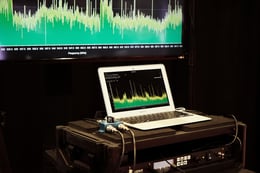 There is a certain path to troubleshooting RF that may produce results, but I have to say that without being able to measure what's going on in the RF environment, the best I can do is guess most times. Gone are the days when you could simply take a dozen new wireless mics out of their boxes, set them to channels 1-12 and have them all up and running. These days there are more wireless devices competing for less available spectrum, and if you can’t see those devices in your venue, you may be switching channels many times until you find a dozen open ones. Maybe the building you're in will shield you from outside interference and you’ll get lucky with the auto-scanning feature on your wireless mic receivers… or maybe not.
There is a certain path to troubleshooting RF that may produce results, but I have to say that without being able to measure what's going on in the RF environment, the best I can do is guess most times. Gone are the days when you could simply take a dozen new wireless mics out of their boxes, set them to channels 1-12 and have them all up and running. These days there are more wireless devices competing for less available spectrum, and if you can’t see those devices in your venue, you may be switching channels many times until you find a dozen open ones. Maybe the building you're in will shield you from outside interference and you’ll get lucky with the auto-scanning feature on your wireless mic receivers… or maybe not.
Simply put, if you are a trying to run a multi-channel wireless microphone or IEM system, a spectrum analyzer is required equipment. And if your best weapon against interference is the ability to move transmitter frequencies… how do you know where to move them? What is the interference? Is it transmitters in the studio next door or is it noise from an LED wall across the entire operating band? It is very difficult to predict the presence of interfering signals without the use of proper RF measurement equipment, and even harder to find the right solution when you run into them.
So once you get your shiny new spectrum analyzer, now what do you do?
Baseline Scan
The first step is to establish a Baseline Scan.
To do that, turn off ALL your gear … everything in your rack, your stage lighting and ambient lighting, all the video equipment and other electronics, since any of these can emit RF.
Set the sweep range of your spectrum analyzer to include 20-30 MHz above and below the frequency range of your mic receivers. So if your mics operate 470-530 MHz, set your sweep range to 450-550 MHz. Depending on what kind of interference is present, you may want to look further out of band. In the US, that might mean reviewing activity in the 600 MHz band to see if any high power sources [*AHEM* T-Mobile] generating noise down into the 500s.
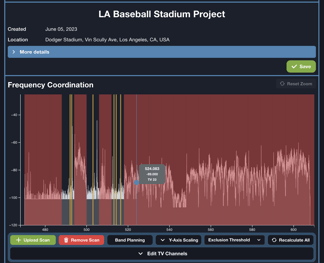
For this setup you will ideally want to use an omni antenna connected to your spectrum analyzer, since the goal is to measure all RF activity present in all directions in the venue. Make sure the analyzer is in a position where it will have good line of sight in all directions and be free from obstructions.
Record and save this measurement as this will be your baseline. Hopefully what you will see are just a few local UHF TV channels with some nice blank space around them and a relatively low noise floor below -80dB (hopefully well below that!).
6 MHz Wide Digital TV Transmitters with carrier frequencies
Now systematically turn things on that will be active in your venue. Starting with your lighting systems and take a new scan. Then turn on your audio gear and make another scan. Hopefully things will change very little and your noise floor will remain low. Now your video projector, monitors, video walls, etc and make another measurement. If no substantial changes occur you’ll be ready to start to calculate what frequencies will be best for your wireless systems in your venue. If you do encounter interference or noise from sources within the venue, it's important to understand where they are located and what type of noise they are introducing. Even if the source itself can't be removed, you can make much better decisions on various aspects of the system like antenna selection and position, filtering, and frequency coordination. And with a solid understanding of Baseline conditions on a new install, you’ll have a much better idea which frequency ranges to specify for the project.
Stay tuned for our next installment in our spectrum analysis series: Operational Scans and Interference Analysis.
Don Boomer
Don Boomer is Senior applications engineer at RF Venue. He has worked in R&D in the past for Peavey, Sabine and Line 6 and his rock band from his high school days has a song in the Rock n Roll Hall of Fame
More from the blog
Subscribe to email updates
Stay up-to-date on what's happening at this blog and get additional content about the benefits of subscribing.


